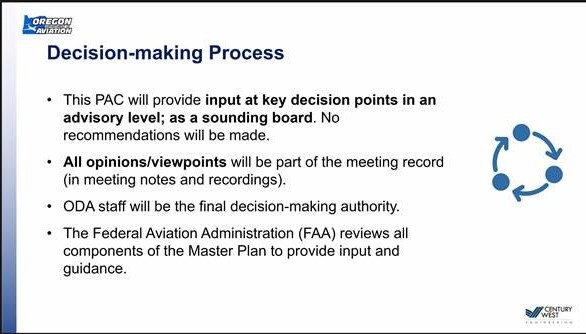In November of 2021 the Oregon Dept. of Aviation (ODAV) launched a new master planning process using Century West Engineering as their aviation consultant and JLA Public Involvement as their facilitator. As we reported to members in an email at the time:
On Tuesday, Nov. 16, Oregon Department of Aviation kicked off the new master planning process with the first meeting of the new Public Advisory Committee. This followed months of give and take about who should comprise the committee, and it should come as no surprise that the initial membership was heavily weighted in favor of the aviation industry. It is also no surprise, but disheartening to report that after broadening the membership, the new master plan process began with a broken public process… just like the one that began in 2009. Why do we say that? It begins with poor management of the Zoom meeting itself, which kept some alternate PAC members from full participation. Additionally, PAC members were polled about their understanding of various subjects as the meeting unfolded, but then the polls results were reframed on the fly by the facilitator. Most notable, though, was the description of “decision making” for the PAC. Specifically, the facilitator explained in detail, PAC members were to serve as a representative for their organizations, and while their opinions would become part of the record:

In other words, the Public ADVISORY Committee will be limited to sharing opinions, and will not be giving advice or making recommendations! Rather, ODA and its aviation consultant Century West will be making the decisions. As the Wilsonville Spokesman reported in their article on the meeting:
A couple members of the public, including Wilsonville resident Steve Benson, expressed dismay during the meeting that their neighborhood wasn’t represented on the PAC. The ODA suggested Benson consult with the city of Wilsonville to speak for him and his neighbors. “Every year we hear more and more traffic flying over our house,” said Benson, who lives in the Daydream Ranch neighborhood. Though it’s considered to be advisory, the committee cannot decide what will go in the plan nor provide recommendations to the ODA. Instead, department staff will have sole power to do so.
Ben Williams, the president of Friends of French Prairie and PAC member, was sharply critical of this dynamic. “I just have to wonder how you’re not embarrassed that you label this committee as advisory, quote unquote, but have already predetermined that you will take no recommendations or advice from the committee,” he said.
Translation? The first PAC meeting certainly created the expectation that the entire master planning process will, once again, be a study in form over substance, and a gross manipulation of Goal 1 concerning public process. If anything, the pandemic requirements of holding public meetings by Zoom allows ODA and their facilitators to even more closely control the content and tone of the meetings—all to achieve the appearance of public process while moving forward with their agenda.
Forecasts Chapter
This master planning process has proceeded at a glacial pace mainly due to over a year’s delay while the FAA reviewed and finally approved Chapter 3, the Forecast chapter. This is the first pivotal chapter because recommendaitons about the future of the airport, specifically expansion, are based on the forecasts of Based Aircraft and Total Operations. The Forecasts chapter was presented to the PAC in a Zoom meeting on January 30, 2026, with minimal discussion and input and only a few minutes scheduled for public comment.
The Forecasts chapter was approved by the FAA before it was made public, and includes:
Master Plan Aviation Activity Forecasts — Chapter 3
The Forecasts chapter lists four Operations Forecast Models that were agreed on with the FAA for consideration in in developing the aviation forecasts for UAO. They are:
- Hybrid TFMSC Itinerant/FAA National Aerospace Forecast GA Local Operations Model
- Marion and Clackamas County Combined Population Growth Model
- National Aerospace Forecast Operations (Airports with ATCT)
- Federal Contract Tower TAF State (Oregon) Model
Note that the Federal Contract Tower TAF State (Oregon) Model is one based on the FAA’s own data built on data from airports in Oregon! In March of 2024, following the FAA approval of the Forecasts chapter, FOFP submitted a comment letter stating:
The FAA “Aurora (UAO) Aviation Activity Forecast Approval letter of November 15, 023 (Corrected January 23, 2024) approves the aviation forecasts from the current Aurora Airport Master Plan process for airport planning purposes. These forecasts are detailed in the table “Airport Planning and TAF Forecast Comparison” derived from data in Chapter 3 (Aviation Activity Forecasts) of the master plan.
The Forecast approval letter goes on to state:
Our approval is based on the following:
- The forecast is supported by reasonable planning assumptions and current data
- The forecast appears to be developed using acceptable forecasting methodologies
- The difference between the FAA Terminal Area Forecast (TAF) and the Airport’s forecast for total operations is within the 10 percent and 15 percent allowance for the 5 and 10 year planning horizons.
However, ODAV’s consultant recommended, and the FAA approved, using the Marion and Clackamas County Combined Populatin Growth Model in spite of the fact that no substantive justification was provided or data presented to make the case that growth model is more accurate and superior to the Federal Contract Tower TAF State (Oregon) Model beyond the assertion: “The model assumes that operations will track with local population, as it reflects the number of people likely to use airport services. This model reflects the best data available considering the limitations of the available ATCT traffic counts.”
Facility Goals and Requirements Chapter
On April 30, 2024, a PAC meeting was held where Chapter 4 was rolled out. [Link to the master plan documents at the bottom of this page]. Once again it was a Zoom meeting where the chapter was presented with minimal discussion and only a few minutes scheduled for public comment.
Based on the spurious operations forecast offered in Chapter 3 that projects a 0.9% average annual increase in Airport operations and found the base craft to be CII, Chapter 4 now proposes a 500′ extension of the 5,000′ runway. The Operations Forecast is based on the alleged combined annual average growth rates projected for Clackamas and Marion Counties; however, the Portland State University data actually shows 0.7%. The FAA Oregon TAF (Terminal Area Forecast) for airports is 0.5% — so ODAV is pushing for a growth rate nearly twice as high. There is no logical connection between growth of operations at Airport and the growth rate of population, especially for an airport that does not offer commercial passenger service.
The chapter states:
Based on local conditions, the standard methodology outlined above and in AC 150-5325-4B, and in coordination with FAA-SEA ADO, a runway length of 5,500 feet is identified to accommodate 100% of large airplanes (60,000 pounds or less maximum gross takeoff weight) at 60% useful load for the current 20-year planning period.
- FACILITY REQUIREMENT. Consistent with FAA planning methodologies a runway length of 5,500 feet at the Aurora State Airport defines the justified runway length for the planning and analyses to be performed in Chapter 5 — Development Alternatives.
- FAA GRANT ASSURANCES AND COMPLIANCE OVERVIEW Upon a review of local”, state, and federal regulations, ODAV is understood to be in compliance with all requirements related to the Aurora State Airport. A detailed discussion of the applicable regulations is presented in Chapter 2 — Existing Conditions Analysis.
- FACILITY GOAL. Maintain current efforts to work with state and federal partners to ensure continued compliance with state and federal regulations.
On May 15, 2024, the City of Wilsonville submitted their comments on the PAC process to date and specifically on Chapters 3 and 4. It raises specific questions about the legality of a master plan process that in part is based on a previous (2012) master plan that was never legally approved or adopted. It then goes on to list a total of 46 questions that have either not been publicly addressed or glossed over in the PAC process.
The City’s letter concludes by stating:
The City alerted ODAV in 2022 regarding the agency’s failure to publish any kind of public notice of the public comment opportunity on Draft Master Plan Chapters 2 through 3 that had a due date of April 12, 2022. The same situation has now occurred again: ODAV failed to publish a public notice for Chapters 3 and 4, in which public comment dates were announced verbally during PAC meetings on March 12 and April 30, 2024, with due dates for public comment respectively “a week after the meeting” and May 14, 2024. City staff alerted ODAV staff on May 3 of the on-going failure to publish public-comment deadlines that help to encourage public participation.
Rather, notice of the opportunity to comment and the deadline for public comments was only provided verbally by ODAV and consultant during the April 5 PAC Work Session meetings. Only after the City contacted ODAV to complain about the lack of public notice did ODAV arrange for public notice of a sort to be buried on the website in text regarding meetings that have been held. Rhetorically speaking, how are members of the public to be aware that there is a public comment opportunity if no public written notice is published or advertised in advance of the comment deadline?
As you can see, the current Aurora Airport master planning process is proceeding in similar (though more organized) fashion as the 2012 master planning process did. Once again it is obvious to an outside observer that the goal is to get a master plan in hand that can be approved and adopted, and one that either recommends expansion or will serve as the basis for making an expansion case in the future.
